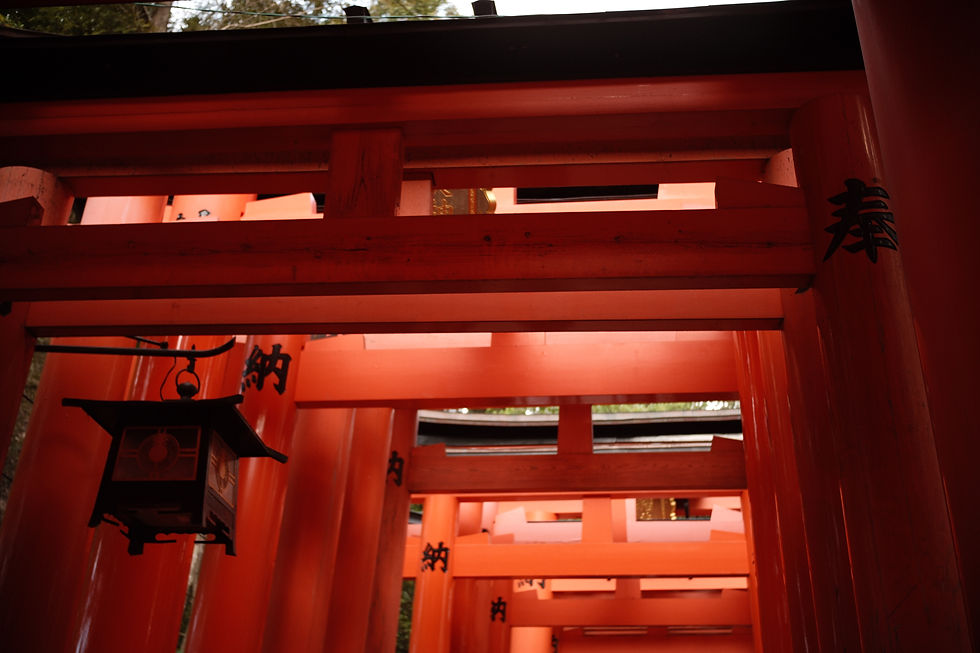Japan Part 2: Tradition and Modernity
- hemcclain
- Dec 20, 2024
- 4 min read
Japan is in many ways a messy mixture of the old and the new. Ancient temples are scattered amongst modern skyscrapers, culinary techniques passed down through countless generations are practiced in world class modern restaurants, and the same people who are leading the world in technology and innovation also embrace their past through fashion, religion, and traditional sports and entertainment. In an American city it's possible to forget a world before 1900, but even in Japan's most modern cities reminders of the past are unavoidable.
Temples and shrines are sprinkled throughout Tokyo and Kyoto with the frequency with which you would find Starbucks in America. We didn't go looking for them but rather they found us - it's hard to avoid stepping into a beautiful spiritual oasis when you're exploring a city in 95 degree heat. Some of my favorite moments in Japan were observing Japanese people at spiritual sites because many times they were enjoying some of the most celebratory moments in life. Even at the most crowded temple sites you could witness meaningful, intimate moments playing out, and the urban backdrop of the surrounding city fading away.

Fushimi Inari Taisha, a Shinto shrine and a must-see in Kyoto, was a highlight for us (and for everyone else visiting Japan - it was very crowded!). Originally built in 711, torii gates are still being added to this site, where you can follow a trail of them up a mountain. It is picturesque, iconic, and actually kind of a challenging hike! We toured it on a 90+ degree day and found that while the heat made the climb difficult, it at least quelled the crowds towards the top. By the time we got there we only encountered a few other intrepid hikers. Maybe it was the incline, or maybe it was the fact that the cold Pocari Sweat energy drinks became pricier at each stop along the way.





See that writing on the gates? We assumed those were all prayers or something similar, until we found one in English - turns out they were corporate and private sponsors!
Japan may be a world leader in modern media and entertainment, but attend a sumo wrestling match and you'll witness centuries-old traditions being carried out that are inextricably linked with ancient Shinto spiritual practice. We learned that the lives of sumo wrestlers are highly regimented and most still live in communal 'stables' where their schedules, diet, and training practices are tightly controlled by their stablemaster, who is generally a retired sumo wrestler. In the sumo arena attendees watch from tatami mats as they cycle through dozens of matches a day. The individual matches last less than ten seconds, but with several minutes of buildup wherein the wrestlers feign, lurch, retreat, and otherwise show off and intimidate each other. Once the fight begins, the first wrestler to be shoved outside the circle loses, and then the ring is purified and swept with salt before the next round.

In the sumo arena, there are no screens, no animated advertisements, and no electronic scoreboard. The matches are announced with calligraphy on large scrolls held up by the referee, or gyōji, between fights. Advertisements are written on banners, which are paraded around the ring during intervals.

Another realm where the past and present are very much adjacent in Japan is transportation. From rickshaws to the ubiquitous Toyota Crown taxis, there was no shortage of ways to get around, but most often we found ourselves relying on Japan's incredible train system. The Tokyo Metro subway was without a doubt the most reliable and convenient form of public transportation I have ever encountered. Even without knowing Japanese it was no problem navigating the train systems, as almost every sign had an English translation. Outside Tokyo, smaller cities each had their own train systems, and being a total train nerd, Ian enjoyed them all!

The amazing bullet train, or Shinkansen, took us back and forth from Tokyo to Kyoto and from Kyoto to Hiroshima, running at about 180mph. The speed was incredible, but even more amazing was how smooth the ride was - no need for cupholders on this train!

The Shinkansen has been in operation since 1964, and incredibly, no one has ever died as a passenger on these trains due to derailment or collision, making it the safest railway system in the world.
We visited the Kyoto Railway Museum where we learned a lot more about Japan's train systems and enjoyed a ride in a old steam engine that they still keep running.

Even just walking around town were were constantly reminded that Japan is very much still living with its history. We didn't have to follow a strict itinerary to extraordinary sights - we spent much of our time basically lost, exploring without following a map and encountering history where we least expected it. We also met Japanese people eager to share their history and traditions with us. While their toilet technology might rival our space program, history still permeates Japanese society, and we loved the contrast between old and new.






Comments